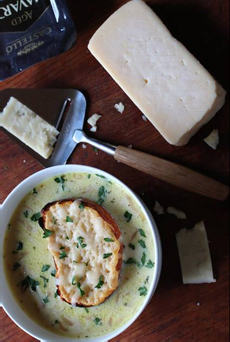TIP OF THE DAY: Soup In A Tea Cup
|
It’s zero degrees here right now, with a wind chill below zero—the coldest February day since 1963. It’s a good day to focus on soup. We prefer to consume soup in a mug instead of a bowl. It can be easily sipped, and we never drip soup on ourselves. Our ability to avoid spilling some soup as it travels from bowl to spoon to mouth is not exactly enviable. Italian chef Stefano Ciotti showed us a more elegant way to sip soup: from a porcelain tea cup. All you need is an old-fashioned shallow tea cup (no mugs!), the soup and some beautiful garnishes. There are garnish options made from bread, dairy, herbs & spices, seeds, fruits and cooked or raw vegetables. Here’s a guide to pairing the right garnish with your soup. You still need to serve a spoon for eating the garnish (an espresso spoon works for us). While you can use a spoon to eat the soup, it’s acceptable to drink it from the cup. Mankind is some 200,000 years old. For the majority of our existence, we had no soup. The earliest humans had no cookware—nothing in which to boil water (or anything else). Boiling was not easy to do until the invention of waterproof containers, probably pouches made of clay or animal skin, about 9,000 years ago. Archaeologists have dated the first soups to about 6,000 B.C.E., some 8,000 years ago. You can trace the origin of our modern word soup from the French soupe, which derived from the Vulgar Latin suppa, which in turn came from the post-classical Latin verb suppare, to soak. This referred to bread soaked in broth, or a liquid poured onto a piece of bread. The bread added heft to the meal. In Germanic languages, the word sop referred to the piece of bread—often a use for stale bread—used to soak up soup or stew. The word entered the English language in the 17th century exactly as that: soup poured over sops of bread or toast. Eating the soaked bread with one’s fingers often served as an alternative to using a spoon (flatware was costly). Today’s soup croutons evolved from sops. Prior to sop/soup, soups were called broth or pottage. |

|
|
|
Soups For The Rich, Soups For The Poor While the rich enjoyed elaborate soup courses (think of modern bouillabaisse, chicken in the pot, cioppino or pho, Vietnamese beef and noodle soup), a simple bowl of soup might be a poor man’s entire dinner. Until recent times, the evening meal was the lighter of the two meals of the day. Soup/sop would be a typical evening dish. The name of the meal evolved to souper, than supper. It began to be fashionable to serve the liquid broth without the sop (bread); and in the early 18th century, soup became a first course. Since it’s a liquid, why do we “eat” a bowl of soup? Because it’s served in a dish, not a cup. If you consume soup from a mug or cup, then you can be deemed to be drinking your soup. So many soups, so little time! Check out the photos in our Soup Glossary and pick out a type of soup you haven’t tried yet.
|
||



